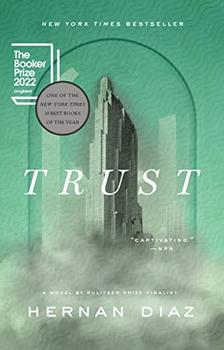Summary | Excerpt | Reviews | Beyond the book | Read-Alikes | Genres & Themes | Author Bio

The MANIAC by Benjamin Labatut is an ambitious work that falls squarely into the category of fiction of ideas. This is the first book written in English by the Chilean author, whose last novel When We Cease to Understand the World, translated from the Spanish by Adrian Nathan West, was included on the New York Times Book Review's 10 Best Books of 2021. In his novels, Labatut creates fictional explorations of the minds of real mathematicians and scientists and traces the development of scientific thought. He is unimpressed by questions of demarcation between fiction and nonfiction, stating, "Anything that comes out of a writer is fiction," and The MANIAC uses a mixture of forms associated with fiction and nonfiction writing.
The MANIAC is divided into three sections: the first is a straightforward, biographical account of the life and death of Austrian physicist Paul Ehrenfest, who in 1933 shot his fifteen-year-old son, Vassily, and then himself. Ehrenfest had been alarmed by the increasingly dangerous Nazi presence in Europe and feared that Vassily, who was disabled, would soon be targeted. In addition, he felt a growing anxiety over changes that the burgeoning theories of quantum mechanics were introducing into the sciences, which negated many previously accepted ideas about the nature of the universe. For Ehrenfest, scientific thought seemed to be spinning out of control, moving further and further into pure abstraction and away from any kind of moral compass. He saw the development as analogous to "young boys birth[ing] the monsters and demons that haunt their dreams, without ever realizing that they have only themselves to blame." Although this first section of the novel is quite short, it lays out one of the underlying questions of the book: Is there a point at which the practice of science moves from a positive to a destructive force for humanity?
The second, and most substantive, part of the novel focuses on the life of John von Neumann, the brilliant-if-blinkered Hungarian American mathematician, physicist, computer scientist, and engineer, who had his prodigious finger in the pot of many 20th-century scientific developments, from quantum mechanics to nascent computer science to nuclear weapons to game theory to artificial intelligence. This part of the novel is arranged as an oral history told in the voices of people who knew von Neumann: his family, his teachers, his colleagues, many of whom worked with him on aspects of the Manhattan Project. Von Neumann's commitment to pure logic—notably disconnected from any moral tether—led to his military work, which included the creation of an early computer, the MANIAC (Mathematical Analyzer, Numerical Integrator, and Computer; see Beyond the Book), used in the development of the hydrogen bomb. Von Neumann also formulated the terrifying doctrine of Mutually Assured Destruction. In this section of the book, Labatut shines as a writer, as he brings to life a complex character who was deeply involved in the creation of one of the most significant scientific inventions in human existence.
The final section looks at some of the contemporary applications of von Neumann's work on computer programming, game theory, and artificial intelligence, by following a seminal competition between a human and a computer playing the Chinese strategy board game Go. Go is significantly more complex than chess, using a 19 x 19 grid of 361 possible playing locations. This section is fascinating, even for a reader who knows little about artificial intelligence or Go, and it has the feeling and tenor of a classic New Yorker deep dive. While this part is in direct dialogue with the first two parts of the book, it can be slightly jarring, as the reader adjusts to a change in subject and a more clipped, journalistic style.
At once historian, biographer, philosopher, and poet, Labatut is adept at eloquently communicating complex ideas in an accessible but not overly simplified style. The MANIAC will appeal to a wide variety of people, from those knowledgeable about math and physics to those, like this reader, with a decidedly more humanities-based education. Labatut creates fully fleshed actors and brings events from the past into sharp, clear focus. With the recent success of the film Oppenheimer, there seems to be increasing interest in the Manhattan Project, and this novel joins the film in reminding us that as we hurtle towards our technological future, we must bear in mind that along with the vast benefits of scientific progress, there can also be long-term costs if innovations are not accompanied by thoughtful consideration of their impact on Earth and on human lives.
![]() This review was originally published in The BookBrowse Review in October 2023, and has been updated for the
October 2024 edition.
Click here to go to this issue.
This review was originally published in The BookBrowse Review in October 2023, and has been updated for the
October 2024 edition.
Click here to go to this issue.

If you liked The MANIAC, try these:

by Hernan Diaz
Published 2023
An unparalleled novel about money, power, intimacy, and perception.

by Colm Toibin
Published 2022
From one of today's most brilliant and beloved novelists, a dazzling, epic family saga centered on the life of Nobel laureate Thomas Mann, spanning a half-century including World War I, the rise of Hitler, World War II, and the Cold War.
Your guide toexceptional books
BookBrowse seeks out and recommends the best in contemporary fiction and nonfiction—books that not only engage and entertain but also deepen our understanding of ourselves and the world around us.